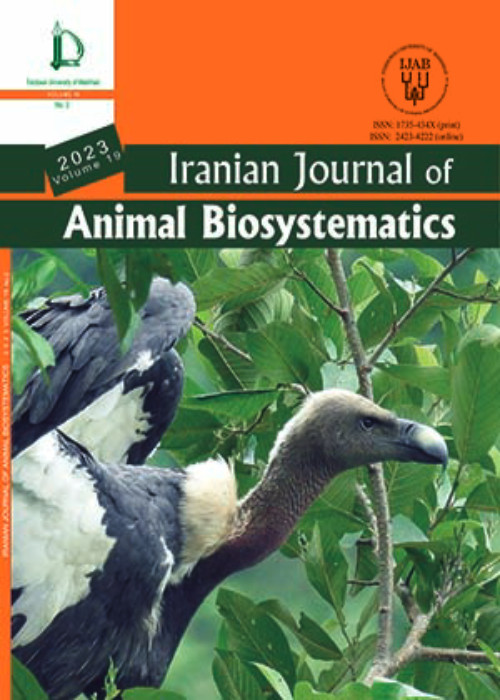فهرست مطالب
Iranian journal of animal biosystematics
Volume:8 Issue: 2, Summer-Autumn 2012
- تاریخ انتشار: 1391/12/08
- تعداد عناوین: 7
-
-
Page 133The tribe Meteorini (Cresson, 1887) (Braconidae: Euphorinae) of Northern Iran was studied. The specimens were collected using Malaise traps during 2010 and 2011. A total of 13 species were collected and identified, among them eight species viz., Zele albiditarsus Curtis, Meteorus alborossicus Lobodenko, M. breviantennatus Tobias, M. cinctellus (Spinola), M. colon (Haliday), M. consimilis (Nees), M. ictericus (Nees) and M. vexator (Haliday) were recorded for the first time from Iran, including new records, number of Meteorini species in Iran is now raised from 6 to 14. Detailed morphological characters for the recorded species and an identification key to the known Iranian species of Meteorini are provided.Keywords: Taxonomy, Braconidae, Euphorinae, Meteorini, Iran
-
Page 155The revised checklist of reptiles for Fars Province, southern Iran, comprises of 63 species in 41 genera, 17 families and two orders (Squamata and Testudines). The most diverse suborder is the Sauria with 38 species or 60.31% of the herpetofauna, followed by Serpentes (23 species, 36.5%) and the Testudines (2 species, 3.17%). The most diverse families are the Colubridae and Gekkonidae with 15 and 14 species (23.8% and 22.2%), respectively, followed by Agamidae (9 species, 14.3%), Lacertidae and Scincidae each with five species or 7.9% of the herpetofauna, and Viperidae (four species, 6.35%). Eleven families have only one species each. The Fars Province is the type locality of several endemic species, as a new species has recently been described as well as several newly recorded species.Keywords: Fars Province, reptiles, herpetofauna, type locality, Iran
-
Vertebrates of Kuh-e-Gorm non-hunting area, Jahrom, Iran: Diversity, conservation and challengesPage 169
-
Page 183Phallocryptus spinosa (Milne-Edwards, 1840) was previously recorded in Iran from a shallow salty pond close to Tabriz, occurring sympatrically with Branchinecta orientalis Sars, 1901; Second and third locations were reported from similar habitats in central area and south of Iran from Bafq and Lar, respectively. Here, a forth population was found during sampling in a pool, about 2000 Km to the south of the first recorded locality. A global distribution map for P. spinosa is presented.
-
Page 191Ophiomorus maranjabensis is a rare scincid lizard which has already been collected from two localities. The first record is from name of locality (Kazemi et al. 2011). Kazemi and his collegues 2011 described this skink as a new species by three collected specimens from N 34°19’52.78”, E 51°53’20.44” and N 34°18’56.50”, E 51°52’45.15”, Maranjab, south of Daryache Namak, Iran (Fig. 1). Our study presented one new record of this species and its habitat in Isfahan Province for the first time.


